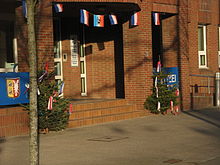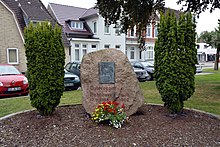Cranberry
Hohnbeer is an annual festival in Heide (Holstein) at the end of winter . During this time, the three so-called Eggen (districts of Heide) celebrate the sense of community and family and the Low German mother tongue. The festivities stretch over several weeks and end on three Saturdays. While the harrows themselves date back to the Middle Ages, Hohnbeer has existed since the mid-19th century.
Surname
The “beer” from Hohnbeer does not mean beer, as one might mistakenly think. Beer is the Low German word for festival; So a festival where the rooster is the center of attention as a symbol of freedom and fertility. This festival goes back to a custom in Schleswig-Holstein, especially Dithmarschen and Stapelholm , in which a living rooster was locked in a wooden barrel. The celebrants threw clubs or stones at this barrel to destroy the barrel and give the rooster its freedom. If the rooster survived this ordeal, it was a sign of good luck and success in the following year.
In 1841 the Eggenbrüder of the Norder-, Süder- and Österegge decided to establish a community festival, which was supposed to promote the feeling of togetherness among the people. They gave this festival the name Hohnbeer. The farmer and wooden slipper maker Jacob-Peter Claußen , known as “Peter Bur” (Süderegge), the teacher and poet Klaus Groth (Österegge) and Andreas Stammer (Norderegge) were the responsible harrow brothers. Instead of locking a rooster in a wooden barrel, it was placed on a barrel as a symbol and Bosseln (a north German sport) was introduced.
The Low German (Low German) language was the language of the poor people at the beginning of the 19th century and therefore not socially acceptable. This only changed with the local poet Klaus Groth von der Österegge, who in his work Quickborn (1852) established the Low German language as a possible literary language.
For more than 170 years now, Hohnbeer has been celebrated by the Eggen every year in February - today on three consecutive Saturdays - to cultivate and promote a sense of community and to preserve the Low German mother tongue. The rooster on the barrel became the symbol of all three Heider harrows. Süderegge and Österegge carry out street boaring and in Norderegge you throw Boßel balls at a wooden tap in a wooden barrel.
The harrows
The harrows were first mentioned in writing in 1462. In the Middle Ages, heather consisted of four harrows. The Eggen (districts) got their name after the respective direction. The Norder-, Süder- and Österegge exist to this day, whereas the Westeregge only existed for a short time. Around 1560 Heide had around 1500 inhabitants (including 60 farmers) in 240 households. Until the city charter was granted on July 7th, 1870, the former patch of Heide consisted of the three harrows as independent sub-communities. The harrows were originally field communities that were administered as independent communities with Meent-Land (common land) and Meent-Werk (common work) with a harrow manager who was also the recorder and accounting officer.
The feast day
In the morning at 6 a.m., the Eggenbrothers meet in their traditional cloakrooms in their Eggenlokal. All active members wear a black top hat, black coat, black suit and the “Wittwark” (white work), white shirt, white bow tie, white gloves and white scarf.
The Schleswig-Holstein song sounds and then the trains march from 06:30 on the set routes to their drink and refreshment points. The Föhrer runs ahead of the train, accompanied by a gendarme as escort, behind the band, the flag delegation and the board members, active members and guests. At the end of the train, the two Kretlers march, making sure that the entire train behaves in an exemplary manner, marches cleanly and that the schedule is adhered to to the minute. At lunchtime, all the honors meet and march together to lunch. The harrow brothers and the invited guests and delegations from the other two harrows have a pea soup and prepare themselves for the bossel competition.
After Boßeln the big parade follows. The parade through the respective harrows ends at the Tivoli Ball and Concert Hall. The coffee table (Festkommers) then takes place in the large hall. Ceremonial speeches will be held, the jubilees and bosses winners will be honored and there will be a lot of squeezing. In the evening, at the end of the festival, there is a festival ball.
literature
- Kai Detlev Sievers (Ed.): Festivals in Schleswig-Holstein. Wachholtz, Neumünster 1984, ISBN 3-529-02672-7 , pp. 75-77.


